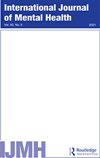Psychological distress, structural barriers, and health services utilization among U.S. adults: National Health interview survey, 2011–2017
IF 1.7
Q3 PSYCHOLOGY, CLINICAL
引用次数: 0
Abstract
Abstract Undertreatment of mental illness is associated with greater acute care and costs and worse mental and physical outcomes. Structural barriers may contribute to worse care. National Health Interview Survey data for 2011–2017 were used to examine associations of psychological distress and nine structural barriers with four health services, guided by the Andersen Behavioral Model of Health Services Utilization. Per the Kessler-6 Scale, United States adults 18–64 years of age (sample size = 172,209, estimated annual population = 189.4 million) were categorized as: no or low psychological distress (NLPD: 79.2%), moderate (MPD: 17.1%), and serious (SPD: 3.7%). Those with MPD and SPD had higher likelihoods of any mental health visit (Adjusted Odds Ratio: 3.53; 8.36, respectively), hospitalization (AOR: 1.16; 1.55), emergency room/department visit (AOR: 1.62; 2.23), and lower likelihood of office visits (AOR: 0.42; 0.64) in the past 12 months compared to NLPD (all p < 0.001). Psychological distress was the largest contributor of explained variation for mental health visits (67%), hospitalization (37%), and ER/ED usage (47%). Adults with SPD and MPD faced structural barriers at higher proportions. For example, reports of “had trouble finding general doctor” were: NLPD (2.2%), MPD (6.0%), and SPD (11.8%). Eight structural barriers were positively associated with ER/ED use and five barriers negatively associated with office visits. Barriers significantly associated with all four outcomes were: “Told health care coverage not accepted” and “Delayed care, couldn’t get appointment soon.” Innovative policy solutions coupled with comparable innovations in care delivery for complex patient populations could ensure equitable access to health services for individuals with psychological distress.美国成年人的心理困扰、结构性障碍和卫生服务利用:2011-2017年全国健康访谈调查
本文章由计算机程序翻译,如有差异,请以英文原文为准。
求助全文
约1分钟内获得全文
求助全文
来源期刊

INTERNATIONAL JOURNAL OF MENTAL HEALTH
PSYCHOLOGY, CLINICAL-
CiteScore
3.80
自引率
20.00%
发文量
32
期刊介绍:
The official journal of the World Association for Psychosocial Rehabilitation, the International Journal of Mental Health features in-depth articles on research, clinical practice, and the organization and delivery of mental health services around the world. Covering both developed and developing countries, it provides vital information on important new ideas and trends in community mental health, social psychiatry, psychiatric epidemiology, prevention, treatment, and psychosocial rehabilitation.
 求助内容:
求助内容: 应助结果提醒方式:
应助结果提醒方式:


